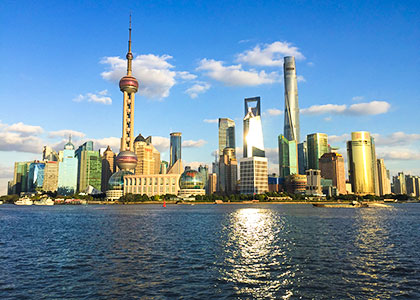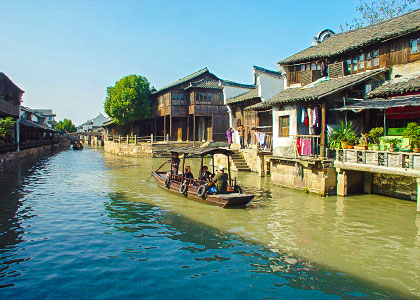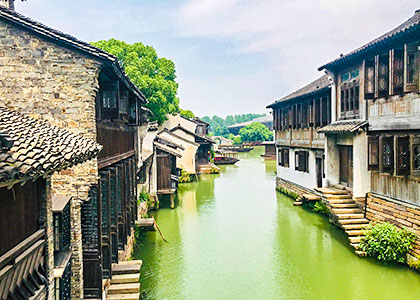One Day Private Shanghai Jewish Tour, No Shopping
Tilanqiao Jewish Isolation Region - Jewish Refugees Museum - White Horse Inn - First Refugee Center - Huoshan Park - Shanghai Children's Palace - Hengshan Moller Villa - Fairmont Peace Hotel
From USD69 per person Book
- Itinerary
- Prices
- Reviews
Trip Highlights
- Listen to the notable events behind the Shanghai Ark during World War II.
- Visit Jewish Refugees Museum for the impressive past about over 20,000 Jewish refugees.
- Learn about once Jewish life scenes by sightseeing First Refugee Center and Huoshan Park.
- No commission-based shopping stops! More time will be spent on attractions and you will enjoy a pure sightseeing tour.
- No optional tours! Optional tour is just a tourist trap and will always cost you more with a high markup on price.
This trip can be customized to meet your individual needs!
At the appointed time this morning, your private guide and driver will meet you at your own booked hotel. The Shanghai private one day tour just starts and you will be guided to visit the former Tilanqiao Jewish Isolation Region first, also named Shanghai Ark Area, meaning the city protected nearly 20,000 Jewish refugees from Europe and erected a "Noah's Ark" for them. This trip will introduce the Jewish dwelling district before and during World War II (1939 - 1945).
Before Italy declared war on Britain and France on June 10, 1940, some German-Jewish refugees went to Italy first, taking more than one month, to take a cruise to reach Shanghai. Tilanqiao had become their first stop upon landing due to its convenient location and low cost of living at that time.
We will first visit the Jewish Refugees Museum, the most important part of the Tilanqiao area. As an old site of the Jewish synagogue, it has now been transformed into a museum to commemorate the history of over 20,000 Jewish refugees in Shanghai during World War II.![Jewish Refugees Museum]()
![Exhibits in Jewish Refugees Museum]() The Museum’s exhibition hall is divided into six parts, Fleeing Shanghai, Life in Refuge, Sharing the Same Ship, Parting after the War, Special Friendship, and Sharing the Future. Up to 161 notable events during the Jewish’s stay are displayed with around 1,000 exhibits and historical materials. You will be amazed by the real stories and memories collected in the museum.
The Museum’s exhibition hall is divided into six parts, Fleeing Shanghai, Life in Refuge, Sharing the Same Ship, Parting after the War, Special Friendship, and Sharing the Future. Up to 161 notable events during the Jewish’s stay are displayed with around 1,000 exhibits and historical materials. You will be amazed by the real stories and memories collected in the museum.
A lace wedding dress embroidered with a lily flower has impressed many visitors. Her owner's name is Betty. In June 1939, Betty's father and his family fled from Germany to Shanghai. While living in Shanghai, Betty met Oleg, a Russian who taught at the Shanghai Yeshiva. They had a date on the Bund and customized the wedding dress on Nanjing Road. The city of Shanghai witnessed their love and the special history.
Opposite the Shanghai Jewish Refugees Museum, you will find the White Horse Inn, which was opened by a Jewish refugee family during the war. Served as a restaurant, bar and night club, so it became a daily gathering place for Jewish refugees. Unfortunately, it was demolished many years ago, and the present café was rebuilt in 2015. The second floor is a small gallery collecting precious historical materials. It is a good idea to have a break here to recall the past.
We will continue our visit to the First Refugee Center on Changyang Road, which is not far away from the White Horse Inn. There were seven shelters in Shanghai to provide assistance to Jewish refugees, and this is the largest one accommodating more than 1,000 people. Some old houses are still standing here and they have inhabited by local citizens now. Strolling along the old street while listening to your local guide’s explanation of the fascinating history in person, you will truly soak up the unique past of the city.![First Refugee Center]()
![Ohel Moshe Synagogue]() The next destination will be Huoshan Park. With an area of only 3,700 square meters (0.91 acre), Huoshan Park was built for foreign children and later became the backyard of the Jewish community for rest and recreation. Nowadays, you can still see the former Jewish refugee shelters inside. There is also one cenotaph recording the gratefulness to Shanghai by Jewish people, written in Chinese, and English.
The next destination will be Huoshan Park. With an area of only 3,700 square meters (0.91 acre), Huoshan Park was built for foreign children and later became the backyard of the Jewish community for rest and recreation. Nowadays, you can still see the former Jewish refugee shelters inside. There is also one cenotaph recording the gratefulness to Shanghai by Jewish people, written in Chinese, and English.
In the afternoon, we will continue our Shanghai Jewish Tour to the Shanghai Children's Palace. The main building was used to be a villa built by a British Jewish businessman. Its marble wall is one of the most distinctive features, which looks very spectacular. After that, we will have a chance to appreciate the gorgeous Hengshan Moller Villa built by a British Jewish businessman in 1936. With Norse style, it is very unique in Shanghai city. When you are there, you could almost feel the presence of history in every part of the building. The last visit of the day will be the Fairmont Peace Hotel. With around 100 years history, the Fairmont Peace Hotel enjoys rich heritage and has been one of the most famous landmarks in Shanghai.
By the end of the Shanghai Jewish tour, your guide will escort you back to the hotel.
► Recommended Dining Option for Dinner (at your own expense):
Wangxilou Food Court is conveniently located opposite the Fairmont Peace Hotel, just a stone's throw away from the bustling Bund on Nanjing East Road. It will first impress you with its retro-style décor, especially the vibrant neon lighting, which radiates modern vibes of the Republican era (1912 - 1949). The food court offers a comprehensive variety of snacks, including local Shanghai delicacies and those from other parts of China. You can experience the flavors of the whole country without leaving the city, or simply stroll around to browse for souvenirs, which the place also offers, and take in local culture and history.
Average cost per person here to get you full is CNY 80 / USD 11
Address: 1F, No.61, East Nanjing Road, Huangpu District
Before Italy declared war on Britain and France on June 10, 1940, some German-Jewish refugees went to Italy first, taking more than one month, to take a cruise to reach Shanghai. Tilanqiao had become their first stop upon landing due to its convenient location and low cost of living at that time.
We will first visit the Jewish Refugees Museum, the most important part of the Tilanqiao area. As an old site of the Jewish synagogue, it has now been transformed into a museum to commemorate the history of over 20,000 Jewish refugees in Shanghai during World War II.
Jewish Refugees Museum
Exhibits in Jewish Refugees Museum
A lace wedding dress embroidered with a lily flower has impressed many visitors. Her owner's name is Betty. In June 1939, Betty's father and his family fled from Germany to Shanghai. While living in Shanghai, Betty met Oleg, a Russian who taught at the Shanghai Yeshiva. They had a date on the Bund and customized the wedding dress on Nanjing Road. The city of Shanghai witnessed their love and the special history.
Opposite the Shanghai Jewish Refugees Museum, you will find the White Horse Inn, which was opened by a Jewish refugee family during the war. Served as a restaurant, bar and night club, so it became a daily gathering place for Jewish refugees. Unfortunately, it was demolished many years ago, and the present café was rebuilt in 2015. The second floor is a small gallery collecting precious historical materials. It is a good idea to have a break here to recall the past.
We will continue our visit to the First Refugee Center on Changyang Road, which is not far away from the White Horse Inn. There were seven shelters in Shanghai to provide assistance to Jewish refugees, and this is the largest one accommodating more than 1,000 people. Some old houses are still standing here and they have inhabited by local citizens now. Strolling along the old street while listening to your local guide’s explanation of the fascinating history in person, you will truly soak up the unique past of the city.
First Refugee Center
Ohel Moshe Synagogue
In the afternoon, we will continue our Shanghai Jewish Tour to the Shanghai Children's Palace. The main building was used to be a villa built by a British Jewish businessman. Its marble wall is one of the most distinctive features, which looks very spectacular. After that, we will have a chance to appreciate the gorgeous Hengshan Moller Villa built by a British Jewish businessman in 1936. With Norse style, it is very unique in Shanghai city. When you are there, you could almost feel the presence of history in every part of the building. The last visit of the day will be the Fairmont Peace Hotel. With around 100 years history, the Fairmont Peace Hotel enjoys rich heritage and has been one of the most famous landmarks in Shanghai.
By the end of the Shanghai Jewish tour, your guide will escort you back to the hotel.
► Recommended Dining Option for Dinner (at your own expense):
Wangxilou Food Court is conveniently located opposite the Fairmont Peace Hotel, just a stone's throw away from the bustling Bund on Nanjing East Road. It will first impress you with its retro-style décor, especially the vibrant neon lighting, which radiates modern vibes of the Republican era (1912 - 1949). The food court offers a comprehensive variety of snacks, including local Shanghai delicacies and those from other parts of China. You can experience the flavors of the whole country without leaving the city, or simply stroll around to browse for souvenirs, which the place also offers, and take in local culture and history.
Average cost per person here to get you full is CNY 80 / USD 11
Address: 1F, No.61, East Nanjing Road, Huangpu District
Tour Prices
| 1 traveler | 2-3 travelers | 4-5 travelers |
|---|---|---|
USD209 | USD119 | USD69 |
- Above prices are per person.
Price Includes
- Private English-speaking guide
- Private driver & air-conditioned vehicle
- Entrance fees to tourist sites
Price Excludes
- Hotel accommodation with breakfasts
- Lunches and dinners
- Tips or gratuities for guide and driver
Itineraries you may also like:


